Fiber Amplifiers
Author: Dr. Paschotta
This tutorial should be useful both as an introduction to fiber amplifiers and for learning more details on them. We believe that even people already having a substantial experience with fiber amplifiers will find it helpful for deepening the understanding. The focus is on the underlying physics and the resulting technical consequences; we do not simply treat a fiber amplifier as a “black box”, but rather look inside.

We do not go into mathematical details, but rather try to create an intuitive understanding of the operation principles – often by demonstrating certain effects with numerically simulated example cases. The simulation and design software RP Fiber Power of RP Photonics is an excellent tool for such purposes and has been extensively used for this tutorial.
Here, we focus on active fibers, containing some laser-active dopant(s). For the basics of fibers, please look at our tutorial on passive fiber optics.
The probably most important application of fiber amplifiers is in optical fiber communications, i.e., data transmission through optical fibers. In long-haul transmission systems, one needs to periodically recover the optical power of signals, e.g. every 50 km of fiber. Also, there are amplifiers used to boost the output of a low-power laser diode generating a signal, particularly before splitting a signal into many fibers (e.g., in cable TV = CATV). Sometimes, amplifiers are used before a receiver to obtain a better signal-to-noise ratio in photodetection. Totally different applications are in high-power laser systems, where fiber amplifiers boost laser radiation to enormous power levels – often for continuous-wave sources, but also for short and ultrashort pulse sources. This tutorial covers the foundations for all such applications.
Click on the headings to get to the following parts of the tutorial:
| 1 |
Part 1: Rare Earth Ions in Fibers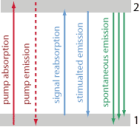
How can erbium or ytterbium ions in a fiber amplify light? How can we describe the behavior of such ions with complex Stark level manifolds and effective transition cross sections? Why are effective transition cross sections temperature-dependent? How does inband pumping work? Why are saturation effects often very strong in fibers? |
| 2 |
Part 2: How to Describe the Light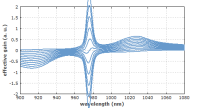
How to calculate the gain and pump absorption from the excitation densities? Why is the shape of the gain or loss spectrum often dependent on the degree of excitation, e.g. in erbium-doped and ytterbium-doped fiber amplifiers? |
| 3 |
Part 3: Self-consistent Solutions for the Steady State
How to calculate a self-consistent steady-state solution for optical powers and excitation densities along the fiber? In which situations is that difficult? What are the limitations of the shooting method and relaxation methods? |
| 4 |
Part 4: Amplified Spontaneous Emission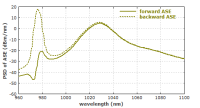
What is amplified spontaneous emission (ASE)? Which factors influence its strength? Why can the power and spectral shape of ASE be strongly depend on the propagation direction? Why does ASE often limit the achievable amplifier gain? |
| 5 |
Part 5: Forward and Backward PumpingWhat are the merits and problems of forward and backward pumping? In which cases does that influence the power conversion efficiency or the amplifier noise level? |
| 6 |
Part 6: Double-clad Fibers for High-power Operation
How does cladding pumping work? Why can it lead to problems with incomplete pump absorption, and how to mitigate these? Why can short-wavelength operation be difficult with double-clad fibers? |
| 7 |
Part 7: Fiber Amplifiers for Nanosecond Pulses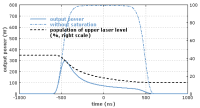
What are the merits and limitations of fiber amplifier systems as sources of intense light pulses? How do they compare with Q-switched bulk lasers? Which nonlinearities can cause trouble for the amplification of short pulses? When does gain saturation lead to pulse distortion? |
| 8 |
Part 8: Fiber Amplifiers for Ultrashort Pulses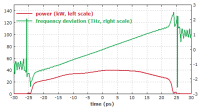
Which additional issues arise for the amplification of ultrashort (picosecond or femtosecond) pulses? How do nonlinear and dispersive effects play together? To which extent can parabolic pulse amplification or chirped-pulse amplification (CPA) mitigate such problems? |
| 9 |
Part 9: Noise of Fiber Amplifiers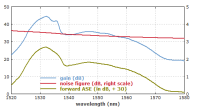
What are the origins of fiber amplifier noise? How is the noise figure defined? Why do quasi-three-level amplifiers have higher noise figures? How can forward pumping of a fiber amplifier be better in this respect? Is the influence of pump noise critical? |
| 10 |
Part 10: Multi-stage Fiber AmplifiersFor what reasons can it be advantageous to use multiple amplifier stages? What methods are available for ASE suppression? How to minimize amplifier noise? |
By the way, on this website we have a lot of other materials on fiber optics – not only the other tutorials, but also a lot of encyclopedia articles on fiber optics and various articles of the Photonics Spotlight (for example, those of 2016-09-12, 2016-08-11, 2016-05-12, 2015-03-11, 2014-07-28, 2013-07-08, 2011-02-10 and 2011-05-28).
Questions and Comments from Users
Here you can submit questions and comments. As far as they get accepted by the author, they will appear above this paragraph together with the author’s answer. The author will decide on acceptance based on certain criteria. Essentially, the issue must be of sufficiently broad interest.
Please do not enter personal data here; we would otherwise delete it soon. (See also our privacy declaration.) If you wish to receive personal feedback or consultancy from the author, please contact him e.g. via e-mail.
By submitting the information, you give your consent to the potential publication of your inputs on our website according to our rules. (If you later retract your consent, we will delete those inputs.) As your inputs are first reviewed by the author, they may be published with some delay.
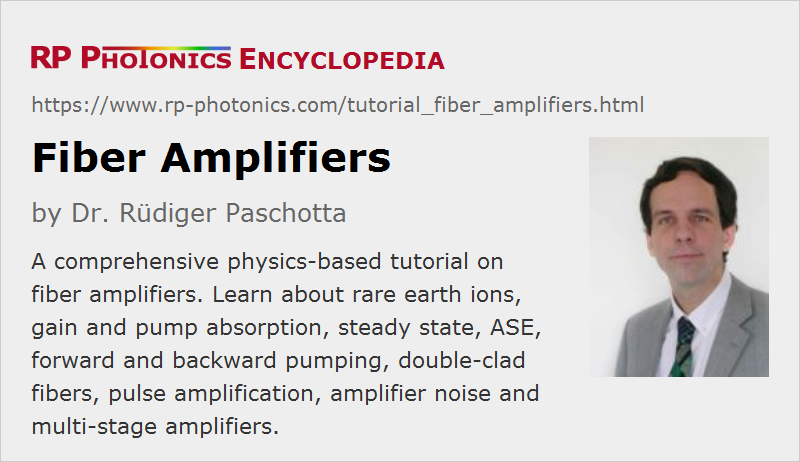 |




If you like this article, share it with your friends and colleagues, e.g. via social media:
These sharing buttons are implemented in a privacy-friendly way!